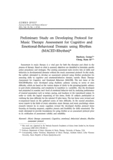

-
 * 본 문서는 배포용으로 복사 및 편집이 불가합니다.
* 본 문서는 배포용으로 복사 및 편집이 불가합니다.
미리보기
서지정보
· 발행기관 : 한국음악치료교육학회
· 수록지 정보 : 인간행동과 음악연구 / 10권 / 1호
· 저자명 : Duerksen George, Chong Hyun Ju
목차
Ⅰ. Introduction
Ⅱ. Development Rationale for Rhythm Protocol for Cognitive Skills and Emotional Behavior
Ⅲ. Procedures of Developing Rhythm Protocol for Assessment
Ⅳ. Developed Rhythm Protocol for Assessment
Ⅴ. Summary and Conclusion초록
음악치료에서 사정평가는 내담자의 현재 기능과 필요를 파악하기 위하여 반드시 선행되어야
하는 과정이다. 음악치료사는 사정평가의 내용을 바탕으로 치료목적 및 목표를 설정하고 이를 달
성하기 위한 단계적 접근과 치료전략을 수립한다. 하지만 기존의 음악치료 사정도구는 해당 영역
의 행동을 열거하고 이를 관찰하여 수치화함으로써 기능을 평가하였기 때문에, 실제 인간의 음악
행동을 통한 기능의 사정이 불가능하다는 단점을 지니고 있다. 또한 음악행동을 바탕으로 하는
소수의 음악치료 사정도구에서도 음악행동을 구성하는 세부기능영역, 발달단계에 따른 근거에 따
른 난이도 검증 과정을 거치지 않고 사용되어 왔다. 본 연구에서는 인지기술 사정을 위한 리듬
요소군을 중심으로 한 음악 프로토콜 문항을 개발하였으며 발달학적 근거와 인지기술 수준에 따
른 난이도 요소를 규명하고자 하였다. 인지발달에 따른 소리정보의 그룹핑, 구조형식의 수준, 전
체-부분 관계의 명료성, 반복-변동성 수준을 고려한 리듬 연주 항목과 연주행동에 내포된 정서 행
동을 분석할 수 있는 리듬 사정 프로토콜을 개발하였다. 검증과정으로는 먼저 15개의 예비 리듬
문항을 난이도, 복합성, 패턴 유형을 고려하여 선정한 후 이를 일반인 61명을 대상으로 난이도
검증을 실시하여 문항별 수준과 난이도 계수를 도출하였다. 둘째, 7인의 전문가 평가팀의 검증을
통해 1차 개발된 문항들을 수정 보완하여 최종적으로 20개의 리듬프로토콜 문항을 개발하였다.
본 연구의 결과는 이후 개발될 음악치료사정평가도구의 기초 자료로 활용될 수 있다.영어초록
Assessment in music therapy is a vital part for both the therapist and client in the
process of therapy. Based on what is assessed, objectives are identified to formulate specific
action procedures and strategies. The existing assessment tools involve lists of skills and
behaviors in developmental domains without the music assessment protocol. In this study,
the authors attempted to develop an assessment protocol using rhythm production for
assessing skills in cognitive and emotional-behavior domain, namely Music Therapy
Assessment for Cognitive and Emotional Behaviors (MACEB). The test items of the
MACEB-Rhythm were developed using rhythmic patterns varying in terms of item
difficulty, which are based on the various degree of clarity in the grouping/gestalt, saliency
in part-whole relationship, and complexity in repetition vs. variability. Also the developed
tool purported to examine one’s level of emotional behavior trait by analyzing performance
of musical parameters such as tempo, pacing, and loudness in the reproduced output. In
order to verify the logical sequencing of test items, firstly 61 subjects participated in
verifying the item difficulty for the selected 15 pilot items. The test items were revised and
re-sequenced based on the gathered scores of item difficulty. In the second procedure,
seven experts in the fields of music education, music therapy and music psychology whose
research interest lie in music cognition revised the developed rhythm protocol items
focusing on learning sequence, cognitive process and feasibility for skills assessment. The
study attempted to provide foundations for using rhythm as an assessment protocol prior
to its verification of assessment validity and reliability.참고자료
· 없음태그
-
자료후기
-
자주묻는질문의 답변을 확인해 주세요

꼭 알아주세요
-
본 학술논문은 (주)학지사와 각 학회간에 저작권계약이 체결된 것으로 AgentSoft가 제공 하고 있습니다.
본 저작물을 불법적으로 이용시는 법적인 제재가 가해질 수 있습니다. -
해피캠퍼스는 구매자와 판매자 모두가 만족하는 서비스가 되도록 노력하고 있으며, 아래의 4가지 자료환불 조건을 꼭 확인해주시기 바랍니다.
파일오류 중복자료 저작권 없음 설명과 실제 내용 불일치 파일의 다운로드가 제대로 되지 않거나 파일형식에 맞는 프로그램으로 정상 작동하지 않는 경우 다른 자료와 70% 이상 내용이 일치하는 경우 (중복임을 확인할 수 있는 근거 필요함) 인터넷의 다른 사이트, 연구기관, 학교, 서적 등의 자료를 도용한 경우 자료의 설명과 실제 자료의 내용이 일치하지 않는 경우
“인간행동과 음악연구”의 다른 논문도 확인해 보세요!
-
음악치료 접근을 통한 특수학교 음악교육 교수·학습 지도안 개발 20 페이지
본 연구에서는 지적장애 중·고등학교 학생들의 효과적인 음악 수업을 위하여 교수·학습 지 도안을 개발하였다. 지도안 구성 시 특수교육 분야에 관련서비스로써 역할을 해 온 음악치료 영 역을 음악 교과 수업 장면에 접목시켰다. 지도안은 2008개정 특수학교 교육과정의 음악과에서 각 영역별로 주제를 재구성하여, 제재를 한 가지씩 선정하였고 교육적, 치료적인 .. -
비음악 전공자들의 음악치료 진로선택과정에 대한 연구 21 페이지
본 연구는 비음악 전공자들의 음악치료 진로선택과정 경험을 살펴보고자 하였다. 이를 위해 서울지역에 소재한 대학의 음악치료전공 대학원생 중 학부에서 음악을 전공하지 않은 학생 5명 을 대상으로 심층면담 하여 근거이론 도출을 위한 예비연구를 수행하였다. 연구 결과, 비음악 전 공자들의 음악치료 진로선택과정은 삶의 구체적 목표 설정에 대한 지속적인 동기와 .. -
A Rationale for Instrumental Music Playing for Upper Extremity Rehabil.. 23 페이지
상지의 운동기능 장애는 뇌졸중 환자에게서 빈번히 보고되는 증상 중의 하나이다. 뇌졸중의 원인인 신경학적 손상의 회복은 발병 초기인 6개월 동안 가장 활발히 일어나며, 이 시기의 회복 은 이후 기능회복에 결정적 영향을 미친다. 독립적인 일상생활 수행과 상지 운동기능의 재활을 위하여 다양한 재활치료 접근이 적용되어 왔으나 그 효과성에 있어서 일관성이 결여..
문서 초안을 생성해주는 EasyAI

